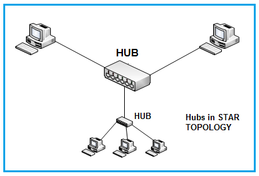5 Advantages and Disadvantages of Hubs in Networking
Advertisement
Introduction : Hubs are fundamental devices in networking, connecting multiple computers within a network. They function by receiving data from one device and distributing it to others, which makes them useful for small-scale network setups. However, with advancements in networking technology, hubs have become somewhat outdated. Let us explore benefits and limitations of hubs and why they’re being replaced by more efficient devices like switches and routers.
What is a Hub?
A hub is a networking device used to connect multiple Ethernet devices (i.e., hosts) using twisted-pair or fiber optic cable. It operates at the physical layer (Layer 1) of the OSI stack. It functions as a multiport repeater, broadcasting data to all ports where devices are connected.
Here are some key features of a network hub:
- Operates in half-duplex mode.
- Available in 4 to 24 port sizes.
- Hosts are responsible for collision detection and retransmission of packets.
- There are three types: active hub, passive hub, and intelligent hub.

How Hubs Work
The following points describe how hubs work:
-
Physical Layer Operation: Hubs operate at the physical layer (Layer 1) of the OSI model, meaning they only deal with electrical signals and not the actual content of the data (like switches or routers do). They don’t make decisions based on the content of data packets or their destination; they simply transmit the signal to all connected devices.
-
Receiving Data: When one device (e.g., a computer or printer) on the network sends data, the hub receives the signal through one of its ports. The data is usually in the form of electrical pulses or binary signals (1s and 0s).
-
Broadcasting Data to All Ports: Once the hub receives data from one port, it replicates the signal and broadcasts it to all other connected devices through the remaining ports. This is called flooding because the hub sends the data to all devices, whether or not they are the intended recipients.
-
Data Collisions: Because the hub sends data to all devices, multiple devices may attempt to send data at the same time, leading to collisions. These collisions occur when two devices try to send data simultaneously, causing interference and corrupting the signals. The affected devices must wait and then retransmit the data, which can lead to reduced network performance.
-
Half-Duplex Communication: Hubs operate in half-duplex mode, meaning that data transmission can only occur in one direction at a time. A device must wait for the hub to finish transmitting data before it can send or receive its own data.
-
Lack of Traffic Management: Hubs do not manage network traffic or direct data to a specific destination. Unlike switches, which can learn the MAC addresses of connected devices and send data to the intended recipient, hubs simply forward data to all devices, making them less efficient for larger or more complex networks.
Advantages of Hubs
- Hubs are inexpensive compared to more advanced networking devices like switches or routers, making them ideal for small networks or budget-conscious setups.
- Hubs require minimal technical knowledge to install and configure, making them a user-friendly option for basic networking tasks.
- For small, simple network setups where data traffic is minimal, hubs provide a sufficient solution to connect multiple devices efficiently.
- Unlike switches or routers, hubs don’t require any complex configuration or management, which simplifies network maintenance for non-technical users.
- Hubs broadcast data to all connected devices, ensuring that all devices receive the same information at once, which can be useful in specific applications like network monitoring or when data needs to be shared widely.
Disadvantages of Hubs
- Hubs lack mechanisms such as collision detection and retransmission of packets, leading to potential data loss and reduced network efficiency.
- Hubs don’t operate in full-duplex mode, which limits the ability to send and receive data simultaneously, resulting in slower overall performance.
- Hubs can’t connect different network architectures such as token ring and Ethernet, limiting their versatility in diverse networking environments.
- Hubs can’t filter information; they pass packets to all connected segments, causing unnecessary traffic and potential security concerns.
- Hubs lack mechanisms to reduce network traffic, which can lead to congestion and decreased performance in larger networks.
Conclusion: Although hubs provide a simple and cost effective solution for small networks, they lack the efficiency and security features of more modern networking devices. Despite their advantages, hubs are mostly outdated and have been replaced by more efficient devices like switches and routers in modern networks.
Advertisement
 RF
RF





